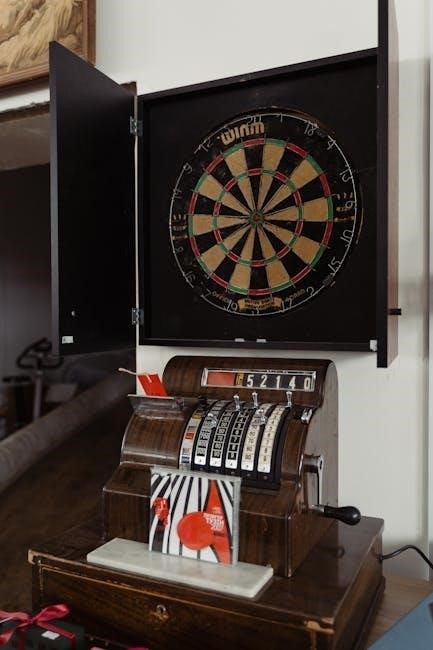FTC Game Manual 2024-2025: A Comprehensive Guide
The 2024-2025 FIRST Tech Challenge Game Manual serves as the ultimate resource, offering teams vital information for the “INTO THE DEEP” season. This comprehensive guide details robot construction rules, game-specific challenges, scoring systems, and official procedures. It’s essential for navigating the competition successfully and understanding all regulations.
The FIRST Tech Challenge (FTC) Game Manual is the cornerstone of every season, providing teams with the essential rules, guidelines, and procedures for participation. This document is not merely a set of regulations; it’s a comprehensive guide designed to ensure fair play, promote innovation, and foster a positive learning environment. For the 2024-2025 “INTO THE DEEP” season, the Game Manual outlines the specific challenges, scoring elements, and competition format that teams will encounter.
Understanding the Game Manual is paramount for teams of all experience levels. It details the constraints and allowances for robot design, the protocols for match play, and the criteria for awards and advancement. The manual’s structure is designed to be accessible, with clear sections addressing different aspects of the competition. From robot construction to software development, the Game Manual provides the necessary information for teams to build competitive robots and engage effectively in the FTC program. It is important to consult this document throughout the season.
Regular review and updates are common, so teams should stay informed of any revisions released by FIRST. The Game Manual serves as a living document, evolving to address emerging questions and clarify existing rules, ensuring that the competition remains exciting and fair for all participants.
Where to Find the Official Game Manual
Accessing the official FTC Game Manual is the first critical step for any team preparing for the season. The primary source for the Game Manual is the official FIRST (For Inspiration and Recognition of Science and Technology) website. Navigate to the FIRST Tech Challenge section, where you will find a dedicated area for the current season, “INTO THE DEEP” for 2024-2025. Here, the Game Manual is typically available as a downloadable PDF document.
It is imperative to ensure that you are accessing the most up-to-date version of the Game Manual. FIRST often releases revisions and addendums throughout the season to clarify rules or address unforeseen issues. Regularly check the official FIRST website for any updates or notifications related to the Game Manual. Downloading the manual directly from FIRST ensures that you have the correct and authoritative version.
In addition to the FIRST website, some regional or affiliate organizations may also provide links to the Game Manual. However, always verify that these links point to the official document hosted on the FIRST website. Relying on unofficial sources can lead to confusion or misinformation. By obtaining the Game Manual directly from FIRST, teams can be confident that they are adhering to the most current rules and guidelines.
Key Sections of Game Manual Part 1
Game Manual Part 1 is a crucial document for FTC teams, encompassing essential information for competition. It features several key sections that teams must thoroughly understand. The introduction provides an overview of the FIRST Tech Challenge season, outlining goals and key events. A significant section details robot construction rules, specifying legal parts, size constraints, and safety guidelines.
Another critical area covers awards and advancement criteria, explaining how teams are judged and selected for advancement to higher-level competitions. Tournament information is also included, detailing event formats, schedules, and logistical considerations. Furthermore, the manual outlines inspection procedures, ensuring robots meet all requirements before competing.
Game Manual Part 1 contains essential definitions and terminology used throughout the competition. Understanding these terms is vital for interpreting rules correctly. Part 1 lays the foundation for a team’s understanding of the competition. Teams should familiarize themselves with all sections to ensure they are well-prepared for designing, building, and competing with their robots, and to stay within the rules.
Understanding Game Rules (Section 11)

Section 11 of the FTC Game Manual, dedicated to game rules, is paramount for teams aiming to compete effectively. This section outlines procedures and consequences for any rule violations during match play. Comprehending these rules is vital to avoid penalties and maximize scoring opportunities.
The game rules section covers various aspects of match play, including robot interactions, gameplay boundaries, and scoring regulations. Teams need to understand the specifics of legal and illegal actions on the field. Details are provided on how points are awarded for completing specific tasks and game elements.
Furthermore, Section 11 clarifies the role of referees and their decision-making process. It explains how referees interpret the rules and administer penalties. Teams should also understand rules pertaining to robot safety and proper conduct during matches. Any violations can lead to disqualifications or point deductions. Familiarity ensures teams can strategize effectively and maintain fair play, contributing to a positive competition experience.
Robot Construction Rules and Guidelines
The FTC Game Manual dedicates a significant portion to robot construction rules and guidelines. These rules are crucial for ensuring fair play, safety, and adherence to competition standards. Teams must meticulously follow these guidelines to avoid disqualification.
The manual specifies limitations on robot size, weight, and materials used in construction. It outlines acceptable parts and components, often referencing a legal parts list that teams must adhere to. Any modifications or additions must comply with the established rules.
Safety is a paramount consideration, with guidelines addressing potential hazards, such as sharp edges, exposed wiring, and battery safety. The manual also details rules regarding robot control systems, including the approved FTC Software Development Kit (SDK) and the use of legal sensors and microcontrollers. Teams are encouraged to consult the manual frequently during the design and build process to ensure compliance and build a robust, competition-ready robot. They must understand rules regarding robot starting configuration and expansion limits during the match.
Match Play Rules and Procedures
The FTC Game Manual meticulously details the rules and procedures governing match play. These guidelines ensure fair competition, safety, and a consistent experience for all teams. Understanding these rules is paramount for strategic gameplay and avoiding penalties.
The manual outlines the match structure, including autonomous and driver-controlled periods, specifying time limits and objectives for each phase. It describes the roles and responsibilities of referees and judges in enforcing the rules and scoring the match. Teams must be aware of the field layout, designated starting positions, and any restricted zones.
Specific rules address robot interactions, including legal pushing, pinning, and defensive strategies. The manual also clarifies prohibited actions that can result in penalties, such as damaging other robots or interfering with game elements outside the permitted parameters. The rules are comprehensive, covering various scenarios that may arise during match play, therefore teams need to carefully study and understand the manual. It includes consequences for violating rules during match play.
Scoring System and Elements
The FTC Game Manual provides a detailed breakdown of the scoring system and game elements, which is crucial for teams to develop effective strategies and maximize their points. This section specifies how points are awarded for completing various tasks during both the autonomous and driver-controlled periods.
The manual clearly defines each game element, including its dimensions, weight, and interaction rules. Teams must understand how to manipulate these elements to achieve scoring objectives. For instance, it details how many points are earned for placing game pieces in specific locations, completing designated patterns, or achieving end-game goals.
Furthermore, the scoring system outlines any bonus points available for completing challenging tasks or achieving specific milestones. Understanding the point values associated with each action is essential for prioritizing tasks and developing a winning strategy. This section also includes how violating rules during MATCH play are outlined. The scoring system also addresses penalties and deductions, ensuring fair and accurate point allocation. Familiarity with the scoring system and game elements is paramount for teams to succeed in the FTC competition.

Awards and Advancement Criteria
The FTC Game Manual dedicates a significant portion to outlining the awards presented at competitions and the criteria for advancing to higher levels of competition. This section is crucial for teams striving for recognition and progression throughout the season. The manual details the various awards, such as the Inspire Award, Think Award, Connect Award, and Design Award, each recognizing different aspects of a team’s performance and contributions.
The criteria for each award are explicitly defined, highlighting the qualities and achievements that judges look for when selecting winners. This includes robot design, innovative solutions, team collaboration, outreach efforts, and adherence to the FIRST core values.
Furthermore, the manual explains the advancement criteria, outlining the pathways for teams to qualify for regional, national, and international championships. These criteria typically involve a combination of performance-based metrics, such as ranking in tournaments, winning specific awards, and demonstrating exceptional teamwork and sportsmanship. Understanding the awards and advancement criteria motivates teams to excel in all areas of the FTC program, fostering well-rounded development and a commitment to excellence.
FTC Software Development Kit (SDK)
The FTC Software Development Kit (SDK) is a crucial component for all teams participating in the FIRST Tech Challenge, serving as the primary tool for programming and controlling their robots. The SDK provides a comprehensive set of libraries, tools, and documentation necessary to develop robust and effective robot control systems. It supports both block-based programming environments, such as Blockly, and Java, catering to teams with varying levels of programming experience.
The SDK allows teams to program their robots to perform a wide range of tasks, including autonomous navigation, object recognition, and precise motor control. It also includes features for integrating sensors, such as cameras, encoders, and gyroscopes, enabling robots to perceive and interact with their environment.
The FTC Game Manual provides detailed information on how to download, install, and use the SDK, including tutorials and sample code to help teams get started. It also outlines the supported programming languages and development environments, ensuring that teams have the resources they need to succeed. Furthermore, the manual emphasizes the importance of understanding the SDK’s capabilities and limitations, encouraging teams to explore its features and develop innovative solutions.
Resources for Rookie Teams (Game Manual Zero)
Game Manual Zero is an invaluable resource designed specifically for rookie teams entering the FIRST Tech Challenge. It provides a curated collection of essential information, guiding newcomers through the fundamentals of the competition. Understanding that embarking on this journey can be daunting, Game Manual Zero simplifies complex concepts and offers clear, concise explanations.
The manual covers a range of topics, from basic robot design principles to fundamental programming concepts. It helps teams grasp the core mechanics of the game and navigate the initial stages of robot construction. Furthermore, it offers practical advice on team organization, fundraising strategies, and effective outreach methods. Rookie teams can learn how to manage their resources efficiently and build a sustainable program.
Game Manual Zero also serves as a stepping stone to the official FTC Game Manual. While the official manual provides comprehensive details, Game Manual Zero extracts the most pertinent information for newcomers, preventing them from being overwhelmed. By focusing on the essentials, it empowers rookie teams to build a solid foundation and confidently participate in their first FIRST Tech Challenge season. It points the teams to the most important pages!
Important Updates and Revisions
Staying informed about important updates and revisions to the FTC Game Manual is crucial for all teams, especially during the active competition season. FIRST releases regular updates to clarify rules, address ambiguities, and refine gameplay mechanics. These updates are essential for ensuring fair play and preventing misunderstandings that could impact match outcomes. Teams should diligently monitor official communication channels, such as the FIRST website, forums, and email newsletters, for announcements regarding revisions.

Updates may cover a range of topics, including robot construction guidelines, scoring clarifications, and procedural adjustments. It’s imperative that every team member, especially those involved in robot design, programming, and strategy, thoroughly reviews each update. Ignoring revisions can lead to unintentional rule violations, penalties, and even disqualification from matches.
The revision history is typically documented, allowing teams to track changes and understand the rationale behind them. This helps teams adapt their strategies and robot designs accordingly. Furthermore, participating in online forums and discussions can provide valuable insights into the implications of updates and best practices for implementation. Proactive engagement ensures that teams remain compliant and competitive throughout the season, adapting to changes.
Accessing Archived Game Manuals

Archived FTC Game Manuals are valuable resources for teams seeking historical context, understanding the evolution of the competition, and gaining insights from past challenges. These manuals provide a wealth of information on previous game designs, robot construction rules, scoring systems, and competition procedures. Accessing archived manuals can be particularly beneficial for rookie teams or those looking to improve their understanding of FTC principles.
The FIRST website typically hosts a repository of archived game manuals, organized by season. These manuals are often available in PDF format, allowing for easy download and offline access. Reviewing past manuals can help teams identify recurring themes, successful strategies, and common pitfalls. This knowledge can inform current robot designs, game strategies, and team management practices.
Additionally, archived manuals can serve as a valuable educational tool for team members, providing a comprehensive overview of FTC history and the evolution of robotics technology. They can also inspire new ideas and approaches to problem-solving. Furthermore, understanding past rule sets can help teams appreciate the rationale behind current regulations and foster a deeper understanding of the competition’s overall goals. Utilizing archived game manuals promotes learning, innovation, and continuous improvement.
